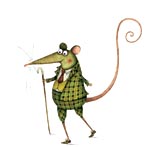Country mouse loves seeing heather
Mark loves seeing the heather this time of year


Few sights gladden the heart more than that of heather in full bloom. I think it looks prettiest on the North Yorkshire moors set against emerald pastureland. Left to nature and its own devices, heather becomes less showy and more straggly. It is only as a result of human activity—the clearing of trees on the poor acidic soil followed by grazing animals or fire—that its full beauty is revealed, which is why the best of the heather is found on grouse moors.
Once the trees were cleared, the heather was locally used by humans as fuel, fodder and a building material. It must have been a harsh existence. Its roots were carved into knife handles for the Scottish dirk and its sweet-scented flowers have been used as an orange dye and for making beer (leann fraoich), once the staple drink of the Highlands. It was also used for what can only have been extremely uncomfortable bedding material.
Today, most of the heather heaths of southern Britain have disappeared, but there are some places in Hampshire and the West Country where it flourishes. There are a still few grouse on Dartmoor and, elsewhere, the rare Dartford warbler and smooth snake cling to existence.
** This article was first published in Country Life Magazine on September 3 2014
* Follow Country Life on Twitter
Exquisite houses, the beauty of Nature, and how to get the most from your life, straight to your inbox.
Mark grew up in the Cotswolds and began his career as a gold prospector. He became editor-in-chief of Country Life in 2006, having previously been in charge of more than 50 magazines, including Horse & Hound. He attributes his success to David Bowie and fly-fishing.
-
 Country Life December 10, 2025
Country Life December 10, 2025Country Life December 10, 2025 is our much loved Christmas Double issue, with 254 pages of seasonal joy.
-
 ‘You get to a point where you do not fancy sleeping alone and dogs have far better manners than men’: Do dogs belong on our beds?
‘You get to a point where you do not fancy sleeping alone and dogs have far better manners than men’: Do dogs belong on our beds?Records of dogs sleeping beside humans stretch back centuries — from Mary, Queen of Scots and Queen Victoria to today’s whippets, teckels and labradors — yet the debate over whether they belong in our beds remains as lively as ever.
